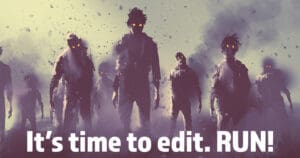I almost included this as a download in last week's recap of LIT-200, but I didn't want to force people to open it in Word when they can just read it here. What you're about to read was posted as a discussion in week eight. My grade was secure by then and I decided to have some fun.
Hi everyone,
I’m going rogue with this discussion and choosing a decidedly non-literary creative work. It’s a film released in 1975 to “great” acclaim. It is adored by millions. It spawned spinoffs. It made stars out of nobodies, and it crushed the box office*.
Jaws?
One Flew Over the Cuckoo’s Nest?
Dog Day Afternoon?
No.
THE ROCKY HORROR PICTURE SHOW.
The Rocky Horror Picture Show is a 1975 film directed by Jim Sharman. It stars Tim Curry, Susan Sarandon, and Barry Bostwick, all of whom still have careers. It also stars Richard O’Brien, Nell Campbell, and Patricia Quinn, who do not.
A pair of young newlyweds, Janet and Brad (Sarandon, Bostwick), are driving through a rainy night when their car breaks down. Distraught, they note that a large home—a castle, really—is nearby and might provide shelter and aid. They approach the castle and are greeted at the door by a servant who leads them inside. The couple is introduced to the head of the household, a doctor of some renown. This doctor is so skilled that he was able to create life in the form of a man named Rocky.
The doctor, Frank, finding himself quite attracted to both Janet and Brad, seduces each. From there, things take a turn. When a scientist shows up inquiring about a missing nephew, Frank catches Janet in flagrante dilicto with Rocky and flies into a rage. His skills as a scientist are once more on display as Frank activates a device that turns Janet, Brad, and Rocky into marble statues. Upon dressing the figures in appropriate cabaret dance attire, the embattled doctor unfreezes the group, and a dance number ensues.
The film ends on a down note as two servants (O’Brien and Quinn) interrupt the performance and demand Dr. Frank-N-Furter accompany them back to their home planet. The good doctor refuses and is killed; the servant indeed becomes the master. The castle is then propelled into the sky, leaving behind its visitors.
I will henceforth apply the New Criticism theory to this masterpiece of the cinematic canon. Cast your mind back to Week Two of this course. The core tenet of New Criticism is that everything one needs to understand a work resides in the work. One need not know anything about the author—the screenwriter, in this case—or the cast or director. Instead, we look solely at the content of the film.

According to the theory of New Criticism, viewers should be looking out for examples of several key concepts. Form is related to structure, and The Rocky Horror Picture Show certainly follows a form; it is laid out in a traditional three-act structure. Actors and directors use technique to give the film complexity and nuance, and this film overflows with both. From the subtle glances shared between characters to the bombastic final dance number and the revelation that many of the characters are aliens, this is no simple movie. According to our study guide from shmoop, ontology is the study of life’s meaning. The final words of this film’s narrator are, “And crawling on the planet’s face, some insects called the human race. Lost in time, and lost in space, and meaning.” A heady ending to a film, to be sure.
We see evidence of paradox in the overthrow of Dr. Frank-N-Furter by his servants and of irony when Frank seduces Janet yet becomes angry when Janet has relations with Rocky.
Also, there are some very small, almost invisible themes of sexuality and queer identity, but I don’t think that anyone really noticed.
~Daniel
Works Cited
Sharman, Jim, director. The Rocky Horror Picture Show. Twentieth Century Fox Home Entertainment, 1975.
Shmoop Editorial Team. “New Criticism Buzzwords.” Shmoop, Shmoop University, 11 Nov. 2008, www.shmoop.com/study-guides/literary-schools-of-theory/new-criticism/buzzwords/.
*it’s technically the second-highest grossing movie of 1975 because it has never been withdrawn from distribution. It holds the record for longest theatrical run—45 years and counting—in movie history.
I'm so glad cell phone cameras weren't a thing in 1993.






